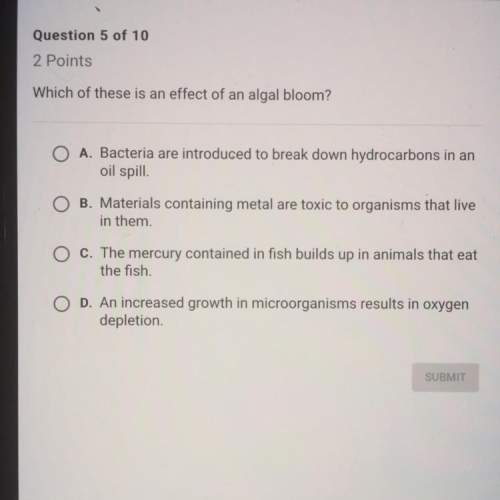
Biology, 10.01.2020 05:31 saltyclamp
Two groups of snails live close to each other on the coast of spain. one group lives in cold water on the lower shores. the lower coast and the snails are protected from large changes in temperatures. the other group of snails lives on the upper shores. the upper shore and the snails that live there are exposed to daily changes in temperature. these two groups of snail are examples of
a) how organisms adapt to their environments.
b) how organisms fight each other for survival.
c) why organisms must move to new environments.
d) why organisms die out when temperatures change.

Answers: 2


Another question on Biology

Biology, 21.06.2019 14:30
Acladogram is a branching diagram that represents suggested evolutionary relationships among organisms based on the presence of unique traits. a scientist discovers a new organism that lacks limbs and does not have a true backbone. the organism lays eggs to produce offspring and has a cartilage-like rod known as a notochord running along its dorsal surface. on the cladogram below, select the species to which the newly discovered organism is most closely related.
Answers: 1

Biology, 22.06.2019 02:30
Sally and sue were investigating the topic of friction in science. they used a small car and a ramp as seen in the picture to test what they were learning. they knew that they slipped easily on waxed floors but not on carpet, so they decided to change the material on the surface of the ramp to see what happened. they planned to use glass, carpet, aluminum foil, and sandpaper and run the car down the ramp over each surface. what would be the best research question to guide the girls' experiment? a) does the amount of surface area affect the friction on the moving car? b) will the car travel fastest on the glass surface? c) how does the angle of the ramp affect the speed of the car? d)do rougher surfaces tend to create more friction than smooth surfaces?
Answers: 1

Biology, 22.06.2019 06:30
Photosynthesis uses co2 and cellular respiration produces co2. we call the point when the two processes are in balance--when there is no net production of co2--the compensation point. how might you limit one of the processes in order to achieve a compensation point?
Answers: 3

You know the right answer?
Two groups of snails live close to each other on the coast of spain. one group lives in cold water o...
Questions


Social Studies, 25.06.2021 22:00



Mathematics, 25.06.2021 22:00





Health, 25.06.2021 22:00

Business, 25.06.2021 22:00









History, 25.06.2021 22:10




